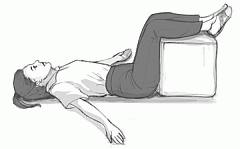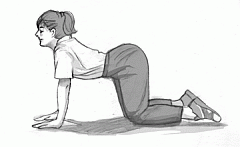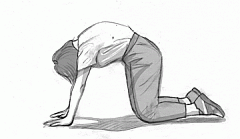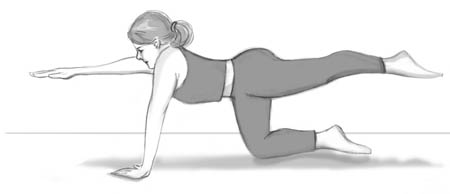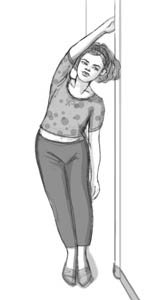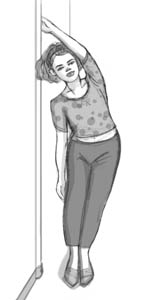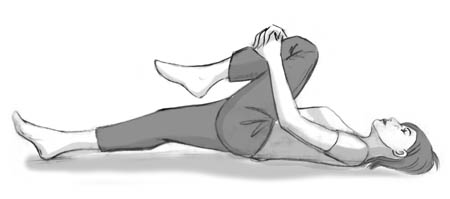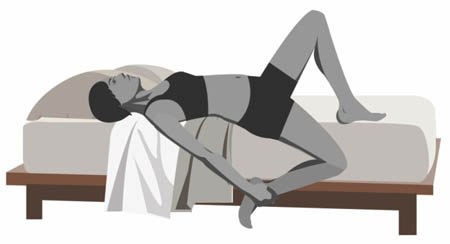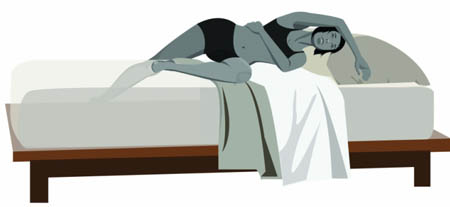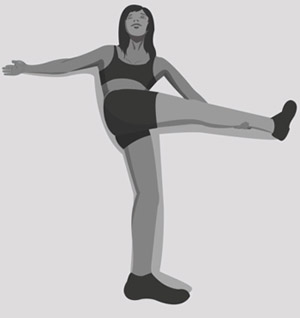|
Back Pain 1.0
Back pain is very common. Most people will have a serious episode of back pain at some point in their lives, many will have repeated episodes. Back pain can be quite disruptive to the daily routine of life, making even the simplest activity a difficult task. The good news is, most people with back pain do recover. The question remains, how fast will you recover, and how completely? Fortunately, the need-to-know information to avoid and/or recover from back pain is based on common sense so it is easy to understand and act upon. The following basic concepts should help you win the battle with most back pain episodes. Condensed from The Science of Sitting Made Simple book.
1. How Your Spine Works
Start by reviewing the fundamental parts and functions of your spine as described in Steps One and Two of the "Learning About Posture" section of this website. It is important to know the normal shape of your spine and how it is held together. 2. Pain On Purpose Pain is a useful form of communication between you and your body. People have most often ignored subtle hints of an impending problem before experiencing a major back pain episode. Pain is useful when it forces you to limit certain activities so that you avoid further injury, for example, pain can help you discover which body positions are better or worse for your particular back problem, or remind you that you have been in one position too long. Although you may be in a hurry to be completely out of pain, it is appropriate that you should feel better only when you actually are better. 3. Knowing the Red Flags A small percentage of the time, back pain can be a sign of a more serious underlying problem. Sometimes the intensity of pain is not as important as the location and the quality or nature of your symptoms, such as tingling / numbness in the groin or legs. One type of pain that raises a red flag is intractable pain, that is, pain without relief no matter what you do or what position you are in. Intractable back pain or back pain with any of the following symptoms should alert you that professional health care is urgently required: - Fever - Leg or arm weakness /incoordination - Loss of bowel / bladder control - Loss of sensation (absence of any feeling) - Unintentional weight loss Be extra careful if you have a health history of traumatic injury, bone thinning, long-term drug use, or cancer.
The following suggestions for managing back pain below will assume that you have NONE of the red flags.
4. Timeframes for Healing
If you have a sudden onset of pain there has usually been a strain of muscles and/or a sprain of connective tissues such as tendons, ligaments, joint capsules, and possibly discs (ACUTE PHASE). Strains and sprains cause small tears in the involved tissues and often result in pain, swelling and reduced motion. Timeframe: 24-72 hours After the acute phase, the repair process is ramping up and the body is mending the torn tissue fibers as best it can (SUB-ACUTE PHASE). People that try to do too much, too soon at this timeframe often re-injure themselves and have to start over again with another acute phase. On the other hand, lack of any motion or activity during this timeframe limits the speed and strength of the healing process. Timeframe: days to weeks If pain or other symptoms such as stiffness or subjective weakness persist beyond the sub-acute phase the injury has likely mended with an inferior quality of tissue compared to the original structure, and muscular support has been weakened (CHRONIC PHASE). It is also possible that minor aggravating activities have repeatedly damaged the weakened structures so that you are caught in a perpetual re-injury/healing cycle. Timeframe: months to years Note: Strictly maintaining good posture in your rest and activity positions to avoid re-injury is essential in all phases of back pain. 5. The Movement Prescription In Step Nine of "Learning About Posture" on this website the importance of movement in maintaining health is explained. Body movement is beneficial in changing the position of joint surfaces, shifting tension of the connective tissues, and providing muscle contraction and lengthening, all of which increases circulation and fluid exchange; essentials for the healing process. In the ACUTE PHASE, the best strategy is rest, support and limited mobility. It is usually comfortable to rest flat on your back, on a firm surface, with your knees up. An elastic back support can help compensate for some of the lost stability that is not being provided by injured muscles, tendons, ligaments, etc, and can be worn almost continuously for up to 48 hours, except when bathing or performing light movements such as gently crawling forward on your hands and knees, or the "cat-cow" yoga stretch. Heavily moderate stretching in the acute phase - less is more. In the SUB-ACUTE PHASE, you can fully bear your own weight and move better through a range of motion. Now is the time to facilitate the speed and quality of the healing process through mobility of the joints, muscles and connective tissues. Walk short distances at an even pace on a flat surface. Slowly attempt: a) standing arm-over-head side bending stretch, b) lying on your back knee-to-opposite shoulder stretch, and c) alternating leg extension exercise (hands and knees starting position, back stays flat, alternate one leg donkey kick). Hold each stretch for about ten seconds (see pictures below). Using a foam roller in this phase can also be helful. In the CHRONIC PHASE, you may benefit from professional help with specific exercise / stretch and ergonomic advice or physical rehabilitation recommendations. Since the "natural course" of back pain is resolution after a few days or weeks (which can be significantly sped up or slowed down by what you do - or do not do, as well as other factors regarding your general health and age), when symptoms do not resolve as expected the exact obstacle(s) to healing must be identified and overcome on an individual basis. 6. Ice or Heat? Temperature changes can assist the healing process and beneficially affect the spine and its supportive structures if used correctly. The intent is to flush the injured area with blood flow, like the rising and falling of the ocean tide, to facilitate delivery of oxygen / nutrition and the removal of waste products. The difference between ice and heat is the way they are used to increase circulation. Ice initially directs blood flow away from the area it's applied. Heat initially directs blood flow into the area it's applied. The ACUTE PHASE: ice is the best choice to direct blood flow away first. Depending on the thickness of the area, a 15-20 minute application is usually sufficient. The ice should then be removed from the skin and the area allowed to return to normal body temperature before reapplying. The SUB-ACUTE PHASE: a combination of ice application, then heat application, repeated over several cycles is the best choice to direct blood flow away from and then into the affected area. After each ice or heat application wait for the body to return to normal temperature before switching to the next application. The CHRONIC PHASE: heat is the best choice to direct blood flow into the affected area first. Depending on the thickness of the area, a 15-20 minute application is usually sufficient. The heat should then be removed from the skin and the area allowed to return to normal body temperature before reapplying. 7. Professional Help There are a number of different health care professionals that work with people suffering from back pain. When is the right time to visit a professional for help with back pain, and which type of practitioner should you choose? Regarding when to go, people with back pain more uncomfortable than they are willing to bear, slower healing than they would consider reasonable, or with fairly consistent recurrent episodes, are good candidates for professional analysis and treatment. Regarding who to see, it is worth mentioning that although there are few certainties when it comes to dealing with back pain in our society, there is one thing for sure: no one type of practitioner can help every type of patient. When seeking professional help, it is usually good advice ask friends, family, co-workers, or another health care provider if they can recommend someone with a good reputation. On-line review sites such as YELP may also be helpful. Here is a basic rundown of the different health care professionals and some of the treatment tools they often use: medical physicians (medication, injections, surgery, osteopathic manipulation), physical therapists (physical therapy modalities, physical rehabilitation, soft tissue and joint mobilization, ergonomic advice), chiropractors(chiropractic manipulation, physiotherapy, soft tissue work, exercise / stretch and ergonomic advice, nutritional counseling), acupuncturists (acupuncture, acupressure, herbal medicine), massage therapists (soft tissue work), athletic trainers and exercise physiologists (physical rehabilitation). Regarding surgery, back pain patients that have the best outcomes with surgery are the ones that need it. That may sound obvious, but the fact is, more back pain patients get surgery than needed. The result has been a poor reputation for back surgery. Back surgery actually works wonders on carefully selected patients and many of the modern procedures can even be performed in an out-patient setting. Do your research carefully if you have been given a surgical recommendation.
8. Dietary Recommendations You need basic nutrition to assist the healing process, and you need to avoid substances that will slow your improvement. Try to eat food that is grown or raised, such as vegetables, fruits, legumes, whole grains, nuts, beef, fish, and chicken, lightly prepared and close to its natural state, because heavily modified foods have far less fiber, vitamins and minerals. In most instances, real food has fewer calories and more nutrients, while processed food has more calories and fewer nutrients. Eat smaller meals frequently as opposed to larger meals infrequently. Moderate caffeine and avoid smoking, alcohol, and any unnecessary medication as these can impair your normal circulation, hydration, and metabolism. Daily nutritional support during healing should include vitamin D3 (2000 IU), magnesium (400mg), omega-3 fatty acids (1000mg), and bromelain (500mg). Summary ACUTE PHASE: ice, rest (flat back), support and limited mobility ("cat-cow" yoga stretch / gentle crawling) SUB-ACUTE PHASE: alternate ice / heat, gradually increase activity / mobility / strength (walking, standing arm-over-head side bending stretch, lying on your back knee-to-opposite shoulder stretch, and alternating leg extension exercise) CHRONIC PHASE: heat, continue non-aggravating activities, stretch and exercise, identify obstacle(s) to healing such as on-going postural faults, scar tissue formation, weakness. The Three Most Common Causes of Back Pain When Sitting 1. Lack of proper support for the arch of the lower back
2. Tight leg muscles
3. Sitting continuously for too long before getting up Recommended Stretches |
|||||||||||||||||||||
|
|||||||||||||||||||||





